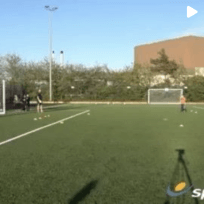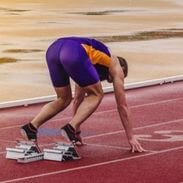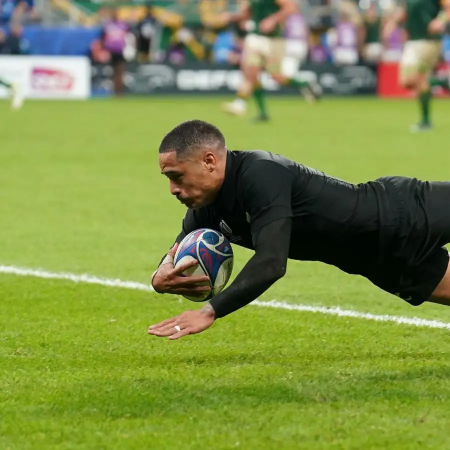Player 1 gets in a defending position in front of player 2 (no ball). Player 2 jogs forward, changing speed and direction (zig-zag), but allowing the defender to remain in front of her throughout. When the players reach the end of the chute, they step to the outside and jog back to their respective lines.
Coach:
• Jockeying position. The defender should ‘open’ (turn) her toes, hips and shoulders toward the nearest side of the grid to channel the ball to the tightest area and limit the attackers’ options.
This closed position also allows the defender to avoid having the ball played between her feet in live play. The defender should also assure that her weight does not shift to her heels, as it becomes very easy for the attacker to make a quick change of pace or direction and lose the defender if her weight is not on the front of her feet (lean slightly forward, legs bent).
Similarly, the defender’s focus must be the ball. Top defenders are not affected by attackers’ body feints because their main focus in a dueling situation is the ball. It is useful to encourage defenders to get their eyes closer to the ball to emphasize this point. It is important not to get too carried away with this point, as a defender too low and leaning too far forward is also easily beaten with a quick touch away. Hand/arm position is also a consideration. Flailing arms can be a source of imbalance and fouls. Top defenders keep their arms and hands comfortably at their sides (some coaches like the defender to hold the bottom of her shorts with the hand nearest the ball to avoid handball calls…) while jockeying. Finally, mentality is critical to quality defending. Passive performance in jockeying exercises often means poor performance in dueling situations. Someone once said that any player transitioning to defense has to, ‘Hunt the ball.’ One of the easiest ways to separate players at tryouts is to watch them defend as individuals. Top players will want to win the ball and will not be satisfied with going through the motions of jockeying and seizing control of a dueling situation.
• Jockeying footwork. The defender should use a ‘chop step’, keeping the feet underneath her (short steps). This shorter step both increases balance and also allows the defender to make quick adjustments to the ball as the attacker begins her run. Finally, the defender’s feet should never come entirely together because at that moment she is vulnerable both of balance and also because she likely has weight on both feet, meaning she will not be able to be powerful in adjusting to the attacker’s movement of the ball.

in more ways than one




in more ways than one




Create a resolution to develop your coaching confidence by seizing the opportunity to discover new drills, turn ideas into action and seek advice from the coaching community.

World Rugby has reportedly conceded Aaron Smith's disallowed try in the World Cup final should have stood.

"It is not only useful for staff who are experienced but a valuable tool for those subject staff who have to take teams."